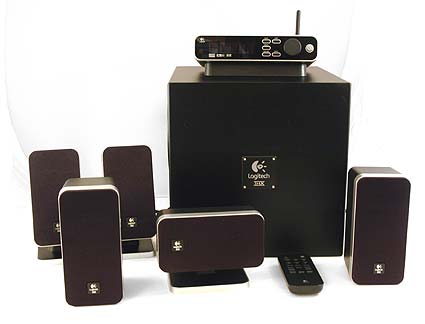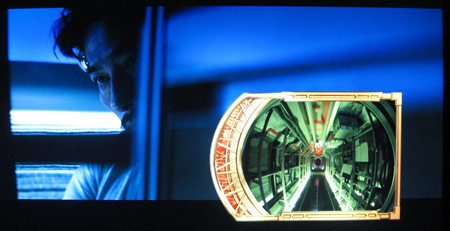Updated: AMD 785G: The Venerable 780G, Evolved
Features For The Home-Theater Crowd
Let's have a look at the 785G's new features and how these might benefit the end user.
Eight-channel LPCM audio support over HDMI (Updated)
Ed.: Having just discussed this issue with AMD, it appears that 785G was never claimed to include eight-channel LPCM. Rather, this was a mistaken assumption given the Radeon HD 4200-class GPU and HDMI 1.3 feature update (versus 1.2 for 780G) exacerbated by the fact that we didn't have a stereo receiver on-hand to actually test whether the feature was actually working. In fact, AMD says the chipset's audio block has not changed at all since the 780G. We've updated the complete review where it was needed, apologize for the mis-information, and promise diligence in the future. For anyone running six-channel audio setups, digital audio output is still able to pass encoded Dolby Digital/DTS, just as the 780G was able to do.
Arguably, the most compelling feature for the hardcore home-theater enthusiast is eight-channel LPCM uncompressed audio support over HDMI. As it turns out, the 785G does not offer this functionality.
There has been some conflicting information released about this feature. AMD even mentions it on the 785G chipset overview page on their Web site:
To AMD's defense, footnote 3 mentions that "Full enablement of some ATI Avivo™ HD capabilities may require complementary products." However, the sentence including "HDMI with 7.1 audio surround sound support" does not reference footnote 3, instead referencing footnote 4: "Not all features will be supported on all machines. Check with your PC manufacturer for specific model capabilities and supported technologies."
Regardless, the important thing is that we clarify that the 785G does not support eight channel LPCM over HDMI, as originally stated.
Get Tom's Hardware's best news and in-depth reviews, straight to your inbox.
While the Intel G45 and Nvidia 8200/9300/9400 chipsets have supported this feature since their release, AMD's 780G/790GX have been limited to two-channel LPCM over HDMI. This is somewhat ironic, since AMD's Radeon HD series of discrete video cards supported eight-channel LPCM over HDMI before these IGPs came to market.
I have a confession to make: I am not an audiophile. I listen to regular MP3s and think they sound great, so I don't have much of a problem with standard Dolby Digital/DTS. I don't own an HDMI amplifier and make due with the optical connection on Logitech's Z-5450 speaker system, which I inappropriately use in my home theater. It is because of this that eight-channel LPCM doesn't excite me all that much. Even the previous 780G chipset could handle six channels (5.1 sound) of audio using Dolby Digital or DTS and simulate eight channels using a matrix algorithm such as DTS Neo6 or Dolby Prologic IIx. Sure it's lossy, but the difference is hardly perceptible to a guy like me.
Having said that, I can appreciate the audiophile's desire to have access to eight-channel Dolby TrueHD or DTS-HD. Unfortunately for these folks, the 785G is not what we had originally hoped for, as it turns out, it's limited to the same two channel LPCM over HDMI audio as its 780G/790GX predecessors.
It is for this discerning crowd that the 785G chipset offers eight channels of discrete uncompressed audio, which gets decoded by your software player of choice, down-sampled to CD-quality audio due to rights management restrictions and a lack of protected audio paths, and output as linear PCM.
For eight channels of discrete uncompressed audio (decoded by software, downsampled to CD quality due to DRM and a lack of a protected audio path, and output as linear PCM), the GeForce 9300/9400 and Intel G45 chpsets are the way to go. For more on our explorations check out parts one and two of our HTPC series. To this day, the only way to get true Dolby TrueHD or DTS-HD MA is through Asus' Xonar HDAV 1.3 doing pass-through over HDMI.
Video Detail Enhancements in UVD 2.0
The 785G has stepped up video quality with UVD 2.0, compared to UVD 1.0 in the 780G and 790GX chipsets. What this means is that the 785G chipset has the following four features that its predecessors do not:
Dynamic Contrast: Enabling this feature facilitates automatic adjustment of black and white levels for optimum contrast on the fly. Nvidia has offered something similar for a little while now, so it's only natural that AMD would add it to its portfolio of video quality enhancements. It is important to note that AMD warns against enabling the dynamic contrast feature, which it says can negate other image-quality enhancements, such as 3:2 pulldown, detail enhancement, and more.
Picture in Picture Acceleration: This feature will lower CPU utilization when dual video streams are being displayed at the same time. While dual video streams probably aren't a problem for modern low-end CPUs to handle, Nvidia's IGPs have offered this feature for some time. The 785G has the checkbox ticked as well, necessary for BD-Live compliance.
HD Flesh Tone Enhancement: This improves the appearance of skin color, ideally keeping it at natural hues.
HD Color Vibrance: This feature improves the vividness of color.
Features like these can make video enthusiasts weary, as dynamic enhancements have been known to arbitrarily over-saturate and over-contrast the video output. Fortunately, we have the option of leaving it off, so everybody wins.
Current page: Features For The Home-Theater Crowd
Prev Page 785G Northbridge And SB710 Southbridge Vital Statistics Next Page Radeon HD 4200 EnhancementsDon Woligroski was a former senior hardware editor for Tom's Hardware. He has covered a wide range of PC hardware topics, including CPUs, GPUs, system building, and emerging technologies.
-
macer1 the real question is how would this perform if mated to an Atom processor in an nettop.Reply -
mcnuggetofdeath "refined architecture" ? To my knowledge, and please correct me if im wrong, all that was changed between the original phenom and the phenom 2 was the addition of more L3 cache allowing it to do more simultaneously and a die shrink allowing for higher clocks. That does not a refined architecture make. When AMD added an on die memory controller to their processors years ago they had made a huge advancement in architecture. Im sad to see them fall away from the performance crown. Here's hoping their new Bull Dozer architecture brings something genuinely intriguing to the table.Reply -
anamaniac Very interesting.Reply
A integrated GPU that can game. =D
Makes my lil Pentium D with a 4670 seem puny...
3.3GB/s memory bandwidth (single channel DDR2 533... though 2 sticks, it runs in single channel... damn prebuilts) also seems sad on my rig...
macer1the real question is how would this perform if mated to an Atom processor in an nettop.
Good question. A dual core Atom with a 4200 integrated would be nice.
We all know Intel makes shitty mothebroards and AMD makes kickass motherboards anyways. -
SpadeM mcnuggetofdeath^^^ and support for DDR3. Although thats a change to the board, not the CPU.Reply
Not correct, the P2 has a built in memory controller so the switch to ddr3 affected that controller -
apache_lives anamaniacVery interesting.A integrated GPU that can game. =DMakes my lil Pentium D with a 4670 seem puny...3.3GB/s memory bandwidth (single channel DDR2 533... though 2 sticks, it runs in single channel... damn prebuilts) also seems sad on my rig...Good question. A dual core Atom with a 4200 integrated would be nice.We all know Intel makes shitty mothebroards and AMD makes kickass motherboards anyways.Reply
Native ram for a pentium d is PC4200 which has a max of 4.2gb/s per channel etc and the FSB has the max of 6.4gb/s
The Intel atom would most likely underpower any video card out there, and Intel does actually make a good reliable business platform where video performance is not required etc -
I'm sorry, is this an Intel benchmark site? All other reviews put SYSTEM power consumption for Athlon II 250 well below Intel E7200.Reply
-
aproldcuk This article raised a lot of questions for me. What about Hybrid Crossfire for example? What kind of cards can be used together with this new IGP? Is the discrete graphics card on standby if no performance is required? If no then how much extra outlet wattage is expected? And how much extra if actively in use? I'm interested in using the 785G solution in the 24/7 HTPC setup with the possibility to do occasional gaming as well. My current setup with 690G chipset and Athlon 64 X2 BE-2350 CPU draws around 50 watts most of the time and up to 90 watts under heavy load. Is it too much to expect similar levels from 785G and Phenom II X3 705e combo for example?Reply -
wh3resmycar when can we see the mobile version of this? this is most certainly a welcome update compared to the 780g-hd3200 chipset. and beats any nvidia igp hands down. id love to see this on an $700-$800 laptop. good thing im still holding back on buying a new notebook.Reply


